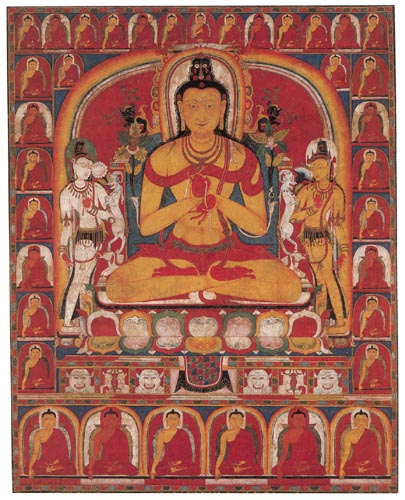| 24. Maitreya Buddha
|

24. Maitreya Buddha
Central Tibet, second half of the 13th century
Distemper on cloth
79.4 x 62.9 cm (311/4 x 243/4 in.
)
Private collection
click on image below for 24: Detail full screen view

24: Detail |
|
Maitreya is most usually depicted as the Buddha of the Future, waiting in the Tushita Heaven for the time to come
when he will be reincarnated as a Brahman. In this thanka, his iconography is more complex. He is depicted
unadorned and wearing the long dhoti and sheer patterned trousers associated with bodhisattvas. He is
flanked by two standing bodhisattvas a white Padmapani and a yellow Manjushri and surrounded by thirty-five smaller Buddhas, all but one assuming
bhumisparsha mudra, the earth-touching gesture that is the standard pose of the Green Tathagata Amoghasiddhi as well as of
the historical Buddha. In one system that links the five Buddhas of the Past with the five Tathagatas, Maitreya is associated with
Amoghasiddhi. This may explain the repeated figures surrounding the main image, albeit with yellow and red
skin colors (not green). Above Maitreya's head a single figure of Vairochana can be identified by the gesture he is
making, dharmachakra mudra, but not by his traditional white skin color, which is yellow here. His position can be
attributed to the fact that he is the head of Maitreya's
line. The thirty-five Buddhas can be divided into seven sets of
five; perhaps each corresponds to the seven Buddhas of the Past.1
Maitreya is seated on a lotus that rests on a throne base inhabited by the ubiquitous beasts. He
holds his hands before his chest in dharmachakra mudra, the gesture of religious discourse. Threaded through his
hands is a stalk that divides into two stems, each terminating in blossoms that flank his shoulders. At his
left is the nagapushpika, or campaka, the flower from which Maitreya's
bodhi tree will emerge. The flower at his
right has at its center a vase, in itself a symbol of the deity.
Behind Maitreya is a large pillow set against a throne back with two tiers; the upper tier is largely obscured by the
two flowers next to his shoulders and is just barely visible under the makara perched on the left. Maitreya's hair is
arranged in a tall chignon, indicative of his future as a Brahman. His garments resemble those worn by the standing bodhisattvas who flank him. The scarf that
encircles his chest is more usually worn by Tathagatas. He lacks most of the elaborate jewelry seen on images of
Esoteric Buddhist deities, including armbands, anklets, crowns, and earrings.
The painting is beautifully rendered, and it radiates a strong presence. The use of shading in the main figure to
give it more dimension is noteworthy. Several elements in the work indicate a date in the last half of the thirteenth
century. A number of the standard motifs associated with the throne ensemble have been misunderstood. The
composition, with its standing figures of bodhisattvas and chorus of listeners, is akin to earlier thankas of Tathagatas, where the deity did not sit against a clearly visible throne back but
only against a pillow (cat. no. 23). Here, the artist has had problems in rationalizing the spatial relationship between
the throne back and the figures. In the original conception, going back to the earliest extant images of
the Buddha in India, the bodhisattvas flanked the main figure. Here, the lotus seat and the rampant
vyalas project
in front of the attendants, which places them behind the entire central ensemble but in front of the surrounding
rainbow, which emanates from their lotus platforms. Another curious feature is the way in which the
makaras are pushed away from Maitreya's aureole so that their foliate tails, instead of abutting it, droop down along the
top of the throne back before commencing their upward spiral (see also cat. nos. 28, 29). It is also unusual that the
right-hand terminus of the throne bar is lower than the one on the left. This was probably done in order to
accommodate the flower just above it , but its structural integrity is compromised. Also, the vyalas do not support the lower crossbar, which floats above their heads.
Finally, the proliferation of deities of various sizes in the borders is another indication of this
thanka's date.
SMK
1. Mallmann 1986, pp. 244-45. This explanation of the side registers is
by no means definitive. [back]
|

